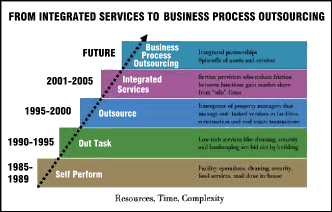
E |
xecutives of the US$11 billion Computer Sciences Corporation understand the business benefits of outsourced services as well as anyone. The El Segundo-based company earned a $344 million profit in its 2002 fiscal year as an outsourcing provider of information technology services to corporations. Check that. Approximately $40 million of Computer Science’s 2002 profits came from cost savings squeezed out of the company’s 10-million-sq.-ft. (930,000-sq.-m.) corporate real estate portfolio — by another outsourcing service specialist, United Systems Integrators Corporation (USI), a real estate service provider based in Stamford, Conn.
Time was, corporate real estate provided a corporate roof for the corporate work place. The real estate might be plain or fancy. Either way, its function was to house company operations. Period.
Today, however, companies expect more of real estate. It must deliver cost savings, provide a source of capital for investment, and support growth.
To achieve those goals, corporations have begun to outsource real estate management to service providers with a broad range of experience in the property markets. Some of these providers manage corporate real estate strategies and costs. Others specialize in services such as sale-leasebacks ta ilored to long-term corporate financing needs. Even developers have gotten into the service act and begun to deliver real estate products with leases negotiated around corporate needs for expansion and contraction that may emerge in the future.
A Corporate Real Estate Service
Industry 10 Years In the Making
Ten years ago, corporations managed their own real estate by assigning transactional tasks to local brokers. The fragmented brokerage industry of that era would have been hard-pressed to mount a strategic management program for a corporation with multiple national and international locations. Sale-leaseback companies dealt largely with debt-stressed clients in need of quick cash. And while developers built office and distribution space to suit corporate needs, lease terms offered little flexibility.
The 1990s changed all of this with the emergence of a new corporate management technique — re-engineering — that contributed to the development of a corporate real estate service industry. “During the recession of those years, corporations re-engineered their organizations,” says Tom Wenkstern, senior managing director of the corporate services group for New York-based Insignia/ESG. “Re-engineering concepts recommended collapsing organizational structures and building more efficient core operations. Outsourcing became popular. Third-party providers could often do non-core work, formerly handled inside the corporation, at lower costs.”
At the same time, continues Wenkstern, real estate brokers struggling with depressed real estate markets began to explore corporate services. Eventually, a host of firms established corporate services departments, which found a ready market among corporations with smaller, re-engineered, in-house real estate staffs. These providers delivered real estate services from a broad base of industry experience, while in-house real estate managers focused that expertise on appropriate corporate goals.
Cutting Corporate Costs By
Outsourcing Real Estate Operations
After several years of experience with outsourced real estate services, corporations are beginning to reap benefits. For companies like Computer Sciences, those benefits have proven substantial.
Until 18 months ago, Computer Sciences managed its owned and leased real estate through an in-house real estate department and a network of preferred brokers with local knowledge of the company’s 400 locations.
In the year 2000, a series of acquisitions led Computer Sciences to re-engineer its traditional approach to real estate management. Senior executives focused on consolidating the company’s recent acquisitions wanted excess costs removed from the corporate structure, including the real estate structure, as quickly as possible.
In response, the real estate department decided to ask for bids from outsource service providers. USI emerged from the bidding competition with a multi-year contract.
|
“Our first step was to build an integrated database that contained all the relevant information about each property in the Computer Sciences real estate portfolio,” says Nick Westley, national managing director and chief strategy officer with USI. The USI team collected information related to lease and property tax costs, lease terms and options, as well as data about how the company was actually using space.
By slicing and dicing this data, USI could tailor economical and effective space decisions to any of Computer Sciences’ eight operating units. If a unit requested an additional 10,000 sq. ft. (930 sq. m.), for example, USI could examine the database and evaluate space utilization in existing properties that might accommodate the new need. Failing that solution, USI could mine the database for expansion options at existing properties. Computer Sciences and USI agreed that they would only consider new space after exhausting all the possibilities that existing space might have to offer.
While building and refining the data platform, USI and Computer Sciences also created short-, intermediate- and long-term real estate strategies designed to meet the company’s cost-cutting and consolidation priorities.
The short-term strategy involved buying out leases and selling assets no longer needed by consolidated business units. Where that was impossible, USI disposed of excess space through sub-leases. In some markets depressed by the recent recession, USI negotiated early lease renewals with landlords that would agree to lower rents in exchange for renewed long-term commitments.
“We completed this short-term strategy by the end of Computer Science’s fiscal year — March 31 of 2002,” Westley says. “These initiatives generated just under $40 million in savings for the year.”
Currently, USI is implementing the intermediate-term strategy, which involves regional real estate consolidation. In Dallas, for example, Computer Science operates in six separate facilities totaling 400,000 sq. ft. (37,200 sq. m.). USI is consolidating these facilities into two buildings in a deal expected to save $25 million over the course of the new lease. According to Westley, USI will pursue similar efforts in three other regional Computer Sciences markets. “Our target this year is approximately $80 million in savings,” he says. The long-term strategy developed for CSC will pursue opportunities such as sale-leasebacks of non-core owned assets.
Additional savings have come through USI’s approach to handling outsourced corporate real estate assignments. According to Westley, the outsourcing model works economically because a service provider can move people from one account to another as needed. For example, USI has assigned six full-time people to the Computer Sciences account. When the account heats up, USI can supplement this staff with specialists in space planning, IT, research, legal issues and other disciplines. As activity slows, the supplemental staff moves on to other accounts. Computer Sciences need no longer staff up in response to changes in activity. That’s USI’s problem.
Fee income from Computer Sciences also allows modifications to the traditional brokerage commission structure. As USI completes transactions, commissions paid by landlords flow into a fund. Commissions over an agreed-upon threshold are shared by USI and Computer Sciences. The company can use its portion of those fees to pay for additional services or just keep the cash, Westley says.
Three years ago, Cushman & Wakefield of New York took over real estate strategic planning, lease administration, transaction management, and project management for a financial services company with 1.9 million sq. ft. (176,700 sq. m.) at 132 sites.
“Prior to employing us, this company had a tactical real estate focus, with no corporate-wide portfolio strategy,” says O. B. (Barney) Upton, III, Cushman’s executive vice president for global corporate services. “When a business unit asked for space, the real estate department would simply lease new space. In addition, the company’s facility and property management functions were being performed internally at costs significantly above where they should have been.”
Cushman has organized the company’s real estate portfolio in a single property management database and streamlined the client’s real estate operations and expenses. “The company’s headquarters operating expenses have fallen by $2.4 million per year,” Upton says. “Overall, the company saved $5.8 million on its real estate portfolio last year.”
Sale Leasebacks And Corporate Financial Management
Corporations are also turning to specialized real estate service providers to help execute real estate strategies connected to their financial plans. At the end of 2001, for example, Atrium Companies Inc., one of the nation’s largest manufacturers and distributors of residential windows and doors, completed a strategic sale-leaseback program when it sold and leased back two of its manufacturing and distribution facilities with the help of W. P. Carey & Co. LLC of New York. The $16.2-million transaction was the final step in a corporate plan designed to convert illiquid real estate into cash available for corporate initiatives.
|
“As a result of this most recent sale-leasback transaction, as well as our two previous transactions, Atrium has been able to access capital that has enabled it to become one of the largest manufacturers and distributors of residential windows and doors in the United States,” says Edward V. LaPuma, executive director of W.P. Carey.
Atrium manages its own real estate, which encompasses about 4 million sq. ft. (372,000 sq. m.) of space spread among 44 sites across the U.S. At one time, the company owned 40 percent of its space. Over the past three years, however, Atrium executed three sale-leaseback transactions involving six sites, all with W. P. Carey. The company now leases 100 percent of its real estate.
“Atrium is in the window manufacturing business, not real estate,” says Jeff L. Hull, president and chief executive officer of Atrium. “Real estate is not a good way for us to manage our assets. As a leveraged-buyout company, we have leverage on our balance sheet, and we have to make very efficient use of our capital. If you have debt in your financial structure, you should have short, medium and long-term debt. A sale-leaseback is a good way to balance short-term debt with long-term debt.
“Overall, we’ve raised $47 million through sale-leaseback transactions and put the money to a range of uses. We’ve financed an acquisition, paid down short-term debt, purchased automated equipment and refurbished a facility where we have consolidated three operations.”
Flexible Development Services For Corporations
Because real estate transmutes liquid cash into illiquid brick and mortar, it can restrict a corporation’s ability to bob and weave with the flow of business. The Alter Group of Skokie, Ill., is helping Thomson Learning Services of Toronto manage this challenge.
|
A distributor of educational textbooks, Thomson has been growing at a rapid 40-percent internal rate in recent years. Acquisitions have boosted overall company growth to even higher levels. Rapid revenue increases — or decreases for that matter — make it difficult for any company to forecast future needs. Will growth continue? Will it tail off a bit? Will it stop altogether? While school-related business will likely continue to expand, will the Internet cut into the business of companies like Thomson?
In 2000, Thomson selected Alter to develop an 835,000-sq.-ft. (77,655-sq.m.) state-of-the-art distribution center in Independence, Ky. A key component of the deal required Alter to provide flexible solutions with an eye on the uncertainties of Thomson’s business forecast.
|
“We found a site that would accommodate the planned facility adjacent to acreage that will allow for expansion to 1.4 million sq. ft. (130,200 sq. m.),” says Kurt Rosene, senior vice president with Alter. “We took an option on the adjacent land. While standard options last two years, this one will last four. In addition, we got a first right of refusal on the land. The lease allows Thomson to cause us to exercise these rights.”
The expansion component of the lease also permits Thomson to increase its space gradually in 100,000-sq.-ft. (9,300-sq.-m.) increments.
Finally, renewal options in the 10-year lease provided Thomson with written guarantees allowing it to reduce its space utilization if business requires cutbacks in the future.
All in all, the job of managing corporate real estate isn’t what it used to be. While corporations must still provide roofs appropriate for company operations, managers must do so with an eye on the true value that real estate decisions may add or subtract from corporate financial statements.
Without compromising the prerogatives of corporate

real estate managers, the real estate professionals have invented a service industry capable of helping, with real estate management techniques that deliver costs savings, capital resources, and support for future business priorities, whatever they may be.




